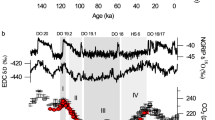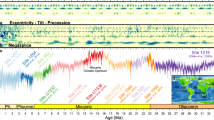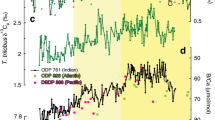Abstract
Current models of the global carbon cycle lack natural mechanisms to explain known large, transient shifts in past records of the stable carbon-isotope ratio (δ13C) of carbon reservoirs1,2. The injection into the atmosphere of ∼1,200–2,000 gigatons of carbon, as methane from the decomposition of sedimentary methane hydrates, has been proposed to explain a δ13C anomaly3,4 associated with high-latitude warming1 and changes in marine5,6,7 and terrestrial8 biota near the Palaeocene–Eocene boundary, about 55 million years ago. These events may thus be considered as a natural ‘experiment’ on the effects of transient greenhouse warming. Here we use physical, chemical and spectral analyses of a sediment core from the western North Atlantic Ocean to show that two-thirds of the carbon-isotope anomaly occurred within no more than a few thousand years, indicating that carbon was catastrophically released into the ocean and atmosphere. Both the δ13C anomaly and biotic changes began between 54.93 and 54.98 million years ago, and are synchronous in oceans and on land. The longevity of the δ13C anomaly suggests that the residence time of carbon in the Palaeocene global carbon cycle was ∼120 thousand years, which is similar to the modelled response after a massive input of methane3,4. Our results suggest that large natural perturbations to the global carbon cycle have occurred in the past—probably by abrupt failure of sedimentary carbon reservoirs—at rates that are similar to those induced today by human activity.
This is a preview of subscription content, access via your institution
Access options
Subscribe to this journal
Receive 51 print issues and online access
$199.00 per year
only $3.90 per issue
Buy this article
- Purchase on Springer Link
- Instant access to full article PDF
Prices may be subject to local taxes which are calculated during checkout



Similar content being viewed by others
References
Kennett,J. P. & Stott,L. D. Abrupt deep-sea warming, paleoceanographic changes and benthic extinctions at the end of the Paleocene. Nature 353, 225–229 (1991).
Bains,S., Corfield,R. M. & Norris,R. D. Mechanisms of climate warming at the end of the Paleocene. Science 285, 724–727 (1999).
Dickens,G. R., O'Neil,R. R., Rea,D. K. & Owen,R. M. Dissociation of oceanic methane hydrate as a cause of the carbon isotope excursion at the end of the Paleocene. Paleoceanography 10, 965–971 (1995).
Dickens,G. R. Methane oxidation during the late Paleocene thermal maximum. Bull. Soc. Géol. Fr. (in the press).
Kelly,D. C., Bralower,T. J., Zachos,J. C., Permoli Silva,I. & Thomas,E. Rapid diversification of planktonic foraminifera in the topical Pacific (ODP Site 865) during the late Paleocene thermal maximum. Geology 24, 423–426 (1996).
Thomas,E. in Global Catastrophies in Earth History: an Interdisciplinary Conference on Impacts, Volcanism, and Mass Mortality (eds Sharpton, V. L. & Ward, P.) 481–495 (Geological Society of America, Boulder, Colorado, 1990).
Thomas,E. in Late Paleocene-Early Eocene Climatic and Biotic Events (eds Aubry, M.-P., Lucas, S. & Berggren, W. A.) 214–243 (Colombia Univ. Press, New York, 1998).
Koch,P. L., Zachos,J. C. & Gingerich,P. D. Correlation between isotope records in marine and continental carbon reservoirs near the Palaeocene/Eocene boundary. Nature 359, 319–322 (1992).
Stott,L. D., Kennett,J. P., Shackleton,N. J. & Corfield,R. M. The evolution of Antarctic surface waters during the Paleogene: inferences from stable isotopic composition of planktonic foraminifera. Proc. ODP Sci. Res. 113, 849–863 (1990).
Thomas,E. & Shackleton,N. J. in Correlation of the Early Paleogene in Northwest Europe (eds Knox, R. W., Corfield, R. M. & Dunay, R. E.) 401–441 (Geological Society, London, 1996).
Pak,D., Miller,K. G. & Browning,J. Global significance of an isotopic record from the New Jersey Coastal Plain: Linkage between the shelf and deep sea in the late Paleocene to early Eocene. Proc. ODP Sci. Res. X 150, 305–315 (1997).
Lu,G. & Keller,G. (1993). The Palaeocene-Eocene transition in the Antarctic Indian Ocean: Inference from planktonic foraminifera. Mar. Micropaleontol. 21, 101–142 (1993).
Bralower,T. J. et al. High resolution records of the late Paleocene thermal maximum and circum-Caribbean volcanism: is there a causal link? Geology 25, 963–966 (1997).
Koch,P. L., Zachos,J. C. & Dettman,D. L. Stable isotope stratigraphy and paleoclimatology of the Paleogene Bighorn Basin (Wyoming, USA). Palaeogeogr., Palaeoclimatol., Palaeoecol. 115, 61–89 (1995).
Clyde,W. C. & Gingerich,P. D. Mammalian community response to the latest Palaeocene thermal maximum: An isotaphonomic study in the northern Bighord Basin, Wyoming. Geology 26, 1011–1014 (1998).
Hooker,J. J. in Late Paleocene-Early Eocene Climatic and Biotic Events (eds Aubry, M.-P., Lucas, S. & Berggren, W. A.) 428–450 (Columbia Univ. Press, New York, 1998).
Röhl,U. & Abrams,L. J. in Proc. ODP Sci. Res. (eds Leckie, R. M. et al.) Vol. 165 (Ocean Drilling Program, College Station, Texas, in the press).
Aubry,M.-P., Berggren,W. A., Stott,L. D. & Sinha,A. in Correlation of the Early Paleogene in Northwest Europe (eds Knox, R. W., Corfield, R. M. & Dunay, R. E.) 353–380 (Geological Society, London, 1996).
Wing,S. L. in Late Paleocene-Early Eocene Climatic and Biotic Events (eds Aubry, M.-P., Lucas, S. & Berggren, W. A. ) 380–400 (Columbia Univ. Press, New York, 1998).
Berggren,W. A., Kent,D. V., Swisher,C. C. III & Aubry,M.-P. in Geochronology, Time Scales and Global Stratigraphic Correlations: A Unified Temporal Framework for an Historical Geology (eds Berggren, W. A., Kent, D. V., Aubry, M.-P. & Hardenbol, J.) 129–212 (Society for Economic Paleontologists and Mineralogists, Tulsa, Oklahoma, 1995).
Norris,R. D. et al. Black Nose Paleoceanographic Transect, Western North Atlantic. Proc. ODP Init. Rep. B 171, 1–749 (1998).
Jansen,J. H. F., Van der Gaast,S. J., Koster,B. & Vaars,A. J. CORTEX, a shipboard XRF-scanner for element analyses in split sediment cores. Mar. Geol. 151, 143–153 (1998).
Herbert,T. D., Premoli Silva,I., Erba,E. & Fischer,A. G. in Geochronology, Time Scales and Global Stratigraphic Correlation (eds Berggren, W. A., Kent, D. V., Aubry, M.-P. & Hardenbol, J.) 81–93 (Society for Economic Paleontologists and Mineralogists, Tulsa, Oklahoma, 1995).
Cande,S. C. & Kent,D. V. Revised calibration of the geomagnetic polarity time scale for the Late Cretaceous and Cenozoic. J. Geophys. Res. 100, 6093–6095 (1995).
Wing,S. L., Boa,H. & Koch,P. L. in Warm Climates in Earth History (eds Huber, B. T., MacLeod, K. & Wong, S. L.) (Cambridge Univ. Press, Cambridge, UK, in the press).
Wing,S. L., Alroy,J. & Hickey,L. J. Plant and mammal diversity in the Paleocene to early Eocene of the Bighorn Basin. Palaeogeogr., Palaeoclimatol., Palaeoecol. 115, 117–155 (1995).
Maas,M., Anthony,M. R. L., Gingerich,P. D., Gunnell,G. F. & Krause,D. W. Mammalian genetic diversity and turnover in the Late Paleocene and early Eocene of the Bighorn and Crazy Mountains Basins, Wyoming and Montana (USA). Palaegeogr., Palaeoclimatol., Palaeoecol. 115, 181–207 (1995).
Gornitz,V. & Fung,I. Potential distribution of methane hydrates in the world's oceans. Glob. Biogeochem. Cycles 8, 335–347 (1994).
Berger,A. Long-term variations of daily insolation and quaternary climatic change. J. Atmos. Sci. 35, 2362–2367 (1978).
Paillard,D., Labeyrie,L. & Yiou,P. Macintosh program performs time-series analysis. Eos 77, 379 (1996).
Acknowledgements
We thank G. Dickens, M. P. Aubry, W. A. Berggren, D. Kent, P. Koch and D. Kroon for discussions, and the staff of the Ocean Drilling Program in Bremen for technical assistance. This work was supported by the Joint Oceanographic Institutions—US Science Support Advisory Committee (JOI-USSAC), and the National Science Foundation and the Deutsche Forhungsgemeinschaft.
Author information
Authors and Affiliations
Corresponding author
Rights and permissions
About this article
Cite this article
Norris, R., Röhl, U. Carbon cycling and chronology of climate warming during the Palaeocene/Eocene transition. Nature 401, 775–778 (1999). https://doi.org/10.1038/44545
Received:
Accepted:
Issue Date:
DOI: https://doi.org/10.1038/44545
This article is cited by
-
Astrochronology of the Paleocene-Eocene Thermal Maximum on the Atlantic Coastal Plain
Nature Communications (2022)
-
Signatures of hyperthermal events in the Late Paleocene–Early Eocene limestone succession of the Jaisalmer basin, India
Carbonates and Evaporites (2021)
-
Comparison and Calibration of Elemental Measurements in Sediments Using X-Ray Fluorescence Core Scanning with ICP Methods: A Case Study of the South China Sea Deep Basin
Journal of Ocean University of China (2021)
-
Biostratigraphic investigation and depositional model of the Late Thanetian Ranikot and the Ypresian Laki formations in the subsurface of the Southern Indus Basin, Pakistan
Arabian Journal of Geosciences (2021)
-
Perspective on the response of marine calcifiers to global warming and ocean acidification—Behavior of corals and foraminifera in a high CO2 world “hot house”
Progress in Earth and Planetary Science (2019)
Comments
By submitting a comment you agree to abide by our Terms and Community Guidelines. If you find something abusive or that does not comply with our terms or guidelines please flag it as inappropriate.



